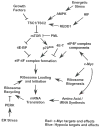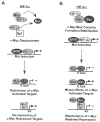HIF and c-Myc: sibling rivals for control of cancer cell metabolism and proliferation
- PMID: 17692803
- PMCID: PMC3215289
- DOI: 10.1016/j.ccr.2007.07.006
HIF and c-Myc: sibling rivals for control of cancer cell metabolism and proliferation
Abstract
O(2) deprivation (hypoxia) and cellular proliferation engage opposite cellular pathways, yet often coexist during tumor growth. The ability of cells to grow during hypoxia results in part from crosstalk between hypoxia-inducible factors (HIFs) and the proto-oncogene c-Myc. Acting alone, HIF and c-Myc partially regulate complex adaptations undertaken by tumor cells growing in low O(2). However, acting in concert these transcription factors reprogram metabolism, protein synthesis, and cell cycle progression, to "fine tune" adaptive responses to hypoxic environments.
Figures



References
-
- Adhikary S, Eilers M. Transcriptional regulation and transformation by Myc proteins. Nat Rev Mol Cell Biol. 2005;6:635–645. - PubMed
-
- Arabi A, Wu S, Ridderstrale K, Bierhoff H, Shiue C, Fatyol K, Fahlen S, Hydbring P, Soderberg O, Grummt I, et al. c-Myc associates with ribosomal DNA and activates RNA polymerase I transcription. Nat Cell Biol. 2005;7:303–310. - PubMed
-
- Arsham AM, Howell JJ, Simon MC. A novel hypoxia-inducible factor-independent hypoxic response regulating mammalian target of rapamycin and its targets. J Biol Chem. 2003;278:29655–29660. - PubMed
-
- Bauer DE, Hatzivassiliou G, Zhao F, Andreadis C, Thompson CB. ATP citrate lyase is an important component of cell growth and transformation. Oncogene. 2005;24:6314–6322. - PubMed
Publication types
MeSH terms
Substances
Grants and funding
LinkOut - more resources
Full Text Sources
Other Literature Sources

